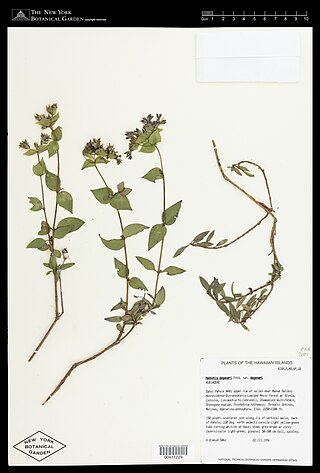
Melicope knudsenii, commonly known as Olokele Valley melicope or Knudsen's melicope, is a species of flowering plant in the family Rutaceae, that is endemic to Hawaii. It inhabits montane mesic forests dominated by Acacia koa, Metrosideros polymorpha, and Dicranopteris linearis on Kauaʻi and East Maui (Auwahi). Associated plants include Syzygium sandwicensis, Cheirodendron trigynum, Myrsine lessertiana, Ilex anomala, Alphitonia ponderosa, Zanthoxylum dipetalum, Kadua terminalis, Pleomele aurea, Bobea spp., Tetraplasandra waimeae, Xylosma hawaiensis, Eurya sandwicensis, Psychotria mariniana, Melicope anisata, Melicope barbigera, Planchonella sandwicensis, Dodonaea viscosa, and Dianella sandwicensis. It is threatened by habitat loss. Like other Hawaiian Melicope, this species is known as alani. This is a federally listed endangered species of the United States.
Melicope pallida, the pale melicope, is a species of tree in the family Rutaceae. It is endemic to the Hawaiian Islands. It is threatened by habitat loss. It is a federally listed endangered species of the United States. Like other Hawaiian Melicope, this species is known as alani.
Merimnetria arcuata is a moth of the family Gelechiidae. It was first described by Lord Walsingham in 1907. It is endemic to the Hawaiian island of Oahu.
Merimnetria homoxyla is a moth of the family Gelechiidae. It was first described by Edward Meyrick in 1928. It is endemic to the Hawaiian island of Oahu.
Merimnetria multiformis is a moth of the family Gelechiidae. It was first described by Edward Meyrick in 1928. It is endemic to the Hawaiian island of Oahu and possibly Hawaii.
Merimnetria thurifica is a moth of the family Gelechiidae. It was first described by Edward Meyrick in 1928. It is endemic to the Hawaiian island of Oahu.
Merimnetria xylospila is a moth of the family Gelechiidae. It was first described by Edward Meyrick in 1928. It is endemic to the Hawaiian island of Oahu.

Kadua is a genus of flowering plants in the family Rubiaceae. It comprises 29 species, all restricted to Polynesia. Twenty-two of these are endemic to the Hawaiian Islands. Some of the species are common at high elevation. Others are single-island endemics or very rare, and a few are probably extinct. Kadua affinis is widely distributed in Hawaii and is polymorphic. The type species for the genus is Kadua acuminata.

Kadua cookiana is a rare species of flowering plant in the coffee family known by the common names 'awiwi and Cook's bluet. It is endemic to Hawaii, where it is known only from Kauai, having been extirpated from Molokai and Hawaii. It is a federally listed endangered species of the United States.

Kadua coriacea is a rare species of flowering plant in the coffee family known by the common name kioʻele. It is endemic to Hawaii, where it is known only from the island of Hawaiʻi and one individual remaining on Maui. It is a federally listed endangered species of the United States.

Kadua degeneri is a rare species of flowering plant in the coffee family known by the common names Waianae Range starviolet and Degener's bluet. It is endemic to Hawaii, where it is known only from the island of Oahu. There are four known populations totalling 370 individuals. It is a federally listed endangered species of the United States.

Kadua laxiflora is a rare species of flowering plant in the coffee family known by the common names Mann's bluet and Hawaiian pilo. It is endemic to Hawaii, where it is known from Molokai, Lanai, and Maui. It is known to exist at four locations for a global population of under 100 plants. It is a federally listed endangered species of the United States.

Kadua parvula is a rare species of flowering plant in the coffee family known by the common name rockface star-violet. It is endemic to Hawaii, where it is known only from the Waianae Mountains on the island of Oahu. It is a federally listed endangered species of the United States.

Kadua cordata is a species of flowering plant in the coffee family known by the common name kopa. It is endemic to Hawaii.

Kadua st-johnii is a rare species of flowering plant in the coffee family known by the common name Nā Pali beach starviolet. It is endemic to Hawaii, where it is known only from the Nā Pali coast of Kauai. It is a federally listed endangered species of the United States.

Spermacoceae is a tribe of flowering plants in the family Rubiaceae and contains about 1346 species in 57 genera. Its representatives are found in the tropics and subtropics.
Junput is a village in Deshapran CD Block in Contai subdivision of Purba Medinipur district in the state of West Bengal, India.

Kadua affinis, the manono or variable starviolet, is a species of flowering plant in the family Rubiaceae, native to the Hawaiian Islands. It is a highly variable plant, with a variety of growth forms including liana, sprawling shrub, shrub, and tree, and yellowish-green to purplish flowers, which a goes long way towards explaining its 200 synonyms.











